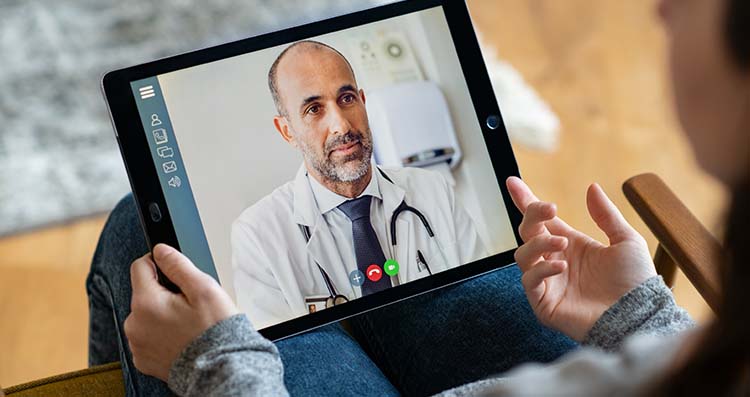Yet another video call? Eight tips for healthy video calls
Since the start of the corona pandemic and mandatory teleworking, the number of video calls has rocketed. Even after the crisis, (occasional) teleworking and video calls will remain common business practice. There are, however, a number of potential risks associated with digital meetings. Gerrit Pollentier, prevention advisor ergonomics at Mensura, offers eight tips for healthy video calls.
Sufficient exercise
- Be smart in your planning and take active breaks. Organise your diary into time slots of 50 minutes. Keep the remaining 10 minutes of every hour free for exercise breaks, away from the screen, and preferably out in the fresh air. After all, exercise fosters concentration and productivity, and results in fewer physical complaints. Even if you simply walk around the table 10 times. During each break, open the window to let in plenty of oxygen. Insufficient ventilation can cause respiratory irritation, inflamed eyes and reduce concentration.
- Limit sitting down. Not every call needs to be made sitting down or from behind your desk. Stand up during short online conversations. In that case, do install your screen at the appropriate height, by using a sit-stand desk, a step on the table or a higher cupboard. Experiment with a walking meeting, and why not try a desk bike?
- Vary your position regularly and stand up for a moment every half hour. Alternate between various sitting and working positions, and regularly rotate your pelvis forwards and backwards. In doing so, you prevent your body from becoming stiff by sitting in the same position for hours.

Focus on the workplace
- Ensure youroffice chair, work surface and screen position are allarranged ergonomically. If you have no office chair, place a cushion under your bottom and a cushion against the backrest to support your lower back. Be sure to use an external keyboard and separate mouse. An external screen or laptop holder is also useful – or you can use a pile of books.
- Choose a separate room as your workplace, or use a secluded part of a room with no background noise, where you will be disturbed as little as possible. Avoid using your bedroom as an office.

Remember your eyes, ears and voice
- Ensure plenty of natural light, but avoid blinding. Position your desk perpendicular to the window and use an extra desk lamp if necessary – or provide sun blinds if the light is too strong. Light sources are best placed behind the camera of your computer as much as possible. Adapt the brightness of the computer screen to suit the light situation.
Blink your eyes consciously to prevent dehydration. Look around from time to time in order to give your eyes a rest: eye muscles only relax when you look a few metres into the distance. Tired eyes can cause headaches, itchy eyes or blurred vision.
- Use a headset or external speakers. Indeed, people often tend to lean their head forwards in order to hear better, which can cause neck complaints. Use a decent headset with good-quality sound, an ergonomic fit, noise restriction and noise cancelling. If you use headphones, avoid setting the volume too high. This can damage hearing. If you use earphones, be sure to clean them regularly. Dirt and bacteria can build up in the earphones, and be pushed into the ear canal.
- Encourage active use of the mute button: Not your turn to speak? Turn off your microphone to prevent annoying background noise and reverberation. Before you begin, agree a signal to use when someone wishes to speak. This is handy, particularly when several people are involved in a video call. Not only does this reduce strain on the voice, it also prevents a cacophony. Use emoticons, or put your hand up either virtually or physically.

How can you help from a distance, as an employer?
Share these tips with employees to remind them of the focus points, for example, via the intranet. As an employer, you can also make an active contribution to improving well-being in the home office.
- Provide material to help create an ergonomic workplace. For example, an adjustable office chair, laptop holder and external mouse and keyboard.
- Ask managers to set an example. For instance, by keeping digital meetings as short as possible, organising a communal moment of standing-up and arranging sufficient breaks during long video calls.
- In addition to considering physical risks, it is also important to remember mental health when working from home for long periods. Otherwise, the danger of a team-out becomes real.
Encourage healthy teleworking with the VDU Work e-survey
With this VDU Work e-survey you get a close look at your employees’ well-being, while also completing a (mandatory) risk analysis among screen workers and teleworkers. As an employer, you will receive a clear report containing actions and recommendations. Your employees will receive specific tips for healthier screen work.